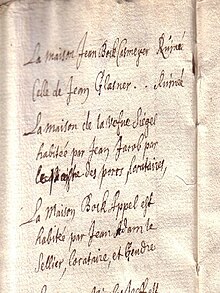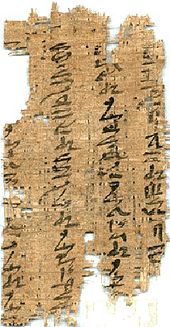Writing material
This article needs additional citations for verification. (June 2019) |

A writing material is a surface that can be written on with
History
Archaeology

Because drawing preceded writing, the first remains of writing materials are the
Four other classes of material were sometimes used for writing:

Writing seems to have become more widespread with the invention of
Cloth probably shared its mode of use with animal skins. Clay introduces the useful combination of extreme ease of making the inscription with the potential for rendering it fairly permanent. Unglazed pottery can readily accept inscriptions even after firing. Wax offers another novel combination of advantages: a reusable surface, easily inscribed and erased, and an easy combination with materials like wood that give it durability.
Unglazed pottery shards were used almost as a kind of scratch paper, as
The archaeological record contains either examples of these materials used for drawing or writing or it has indirect indications of their use for writing, drawing, or tallying.
The
Common writing materials of the Middle Ages
In Western civilizations, papyrus, which originated in 3,000 B.C.E. in Egypt, was later replaced by parchment made by treating animal hides, a process starting in the second century B.C. in the Mediterranean region[4] A wide variety of parchments from various animal skins, with different textures, quality, and hue were widely used for codices, religious and cultural texts. This was replaced by the advent and increasing access and availability of paper.
In eastern civilisations such as
In China, the early material was animal bones, later silk,[5] bamboo, and wooden slips, until the 2nd century when paper was invented. The invention of paper is attributed to a eunuch of the imperial court called Cai Lun in 105 A.D.[5] However, paper was not introduced to Europe for another thousand years following a battle in 751 A.D. where a few paper-makers were captured, and thus the technology spread from Baghdad westward, only reaching Spain in the 12th century.[4]
Paper
Cai Lun used old rags, hemp, tree bark, and fishing nets to develop a method of paper-making fundamentally similar to that still used today.[5]
The world of Islam acquired the art of papermaking in the 8th century, taught by Chinese prisoners who had been taken during eastward expeditions. Eventually, the Muslims brought papermaking to the Indian subcontinent and to Europe.[6] Paper was at first called bagdatikos meaning "from Baghdad". The craft of paper-making reached Spain in the twelfth century, and at subsequent hundred-year intervals arrived in Italy, Germany, and England. Yet for centuries after paper became widely available in Europe, vellum and parchment were preferred for documents that had to be long-lasting. The basic ingredients of paper were linen and cotton, soaked in water and beaten into a smooth pulp, or slurry. As the pulp was drained through a wire screen, the slurry's interlocking fibers matted together, ready for the next step. First, a press squeezed out water from the sheet, preparatory to drying; then, the application of a gelatin coating readied the sheet's surface for ink. [7]
In the late 18th century, paper was still made from cloth gathered by ragpickers.[8] Wove Paper was invented by James Whatman and John Baskerville (1706-75). They created a way to produce perfectly smooth paper, using a fine wire mesh that left no lines from the mould on the page.[9]
Electronic media
Electronic media have utilized the keyboard developed for the typewriter, electrical and electronic circuitry, and storage devices, and the viewing screen developed for reading electronic signals to provide another form of writing material. The Palm Pilot was invented in 1996 and further changed the idea of electronic devices as writing materials. It was the first consumer product that allowed people to write directly on an electronic screen using a stylus, rather than having to input their writing using a keyboard.[10]
See also
References
- ^ Domenici, Viviano; Domenici, Davide (1996). "Talking Knots of the Inka". Archaeology. Vol. 49, no. 6. Retrieved 18 March 2016.
- New York Times. Retrieved January 8, 2016.
- ^ Jacobsen, Lyle E. "Use of Knotted String Accounting Records in Old Hawaii and Ancient China". Accounting Historians Journal. Retrieved 29 August 2016.
- ^ a b Gascolgne, Arthur Bamber. "HISTORY OF WRITING MATERIALS". historyworld.net.
- ^ ISBN 978-1606060834.
- ISBN 978-1-60239-706-4.
- ISBN 978-1-60239-706-4.
- ISBN 978-1606060834.
- ISBN 978-1606060834.
- OCLC 49078768.
Further reading
- Harris, Roy (1985) The Origin of Writing. La Salle, IL: Open Court.
- Martin, Henri-Jean (1988) The History and Power of Writing, translated by Lydia G. Cochrane. Chicago: University of Chicago Press, 1994.
